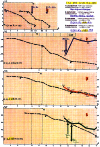Muscular dystrophy, incurability, eugenics
- PMID: 17915566
- PMCID: PMC2949327
Muscular dystrophy, incurability, eugenics
Abstract
The medical entity "muscular dystrophy" has been the object of a recent opinion campaign aimed at promoting a law in favour of euthanasia. This disease has become, in the eyes of the public, a media model of a particularly severe and incurable disease. This very widespread statement does not correspond to reality as far as concerns the life of these patients, to the condition that they have benefited from a very useful and fully provided empirical treatment. As already seen, the hope for life has already doubled, without clear limits. The idea of inducing an interruption when at death's door, as long as a systematic prevention prior to birth, does not conform with the motivated opinion of the majority of patients consulted. On the contrary, the dogma of incurability may lead to dramatic individual consequences which should be stressed, from a medical viewpoint, on account of the unacceptable risks of social injustice or eugenics that this would imply.
Figures





Similar articles
-
The muscular dystrophies.Semin Neurol. 2012 Jul;32(3):255-63. doi: 10.1055/s-0032-1329199. Epub 2012 Nov 1. Semin Neurol. 2012. PMID: 23117950 Review.
-
Creatine phosphokinase in facioscapulohumeral muscular dystrophy.Br Med J. 1971 Aug;3(5772):464-5. doi: 10.1136/bmj.3.5772.464. Br Med J. 1971. PMID: 5567771 Free PMC article.
-
Hereditary muscular dystrophies and the heart.Neuromuscul Disord. 2010 Aug;20(8):479-92. doi: 10.1016/j.nmd.2010.04.008. Neuromuscul Disord. 2010. PMID: 20627570 Review.
-
The muscular dystrophies.Am Fam Physician. 1986 Jul;34(1):123-8. Am Fam Physician. 1986. PMID: 3728255
-
Genetic modifiers of muscular dystrophy: implications for therapy.Biochim Biophys Acta. 2007 Feb;1772(2):216-28. doi: 10.1016/j.bbadis.2006.06.013. Epub 2006 Jul 11. Biochim Biophys Acta. 2007. PMID: 16916601 Review.
References
-
- Heuzé R. “Euthanasie: Rome relance le débat”, Le Figaro, 5 décembre 2006;19390:5; “La mort de Welby ouvre en Italie le débat sur l’euthanasie”, Le Figaro, 22 décembre 2006;19405:5.
-
- Bozonnet JJ. “Euthanasie. Un homme paralysé demande le droit de mourir”, Le Monde, 19 décembre 2006;19253:12.
-
- Chambraud C. “Des militants espagnols pro-euthanasie ont aidé une femme malade à mourir”, Le Monde, 21-22 janvier 2007;19282:6; “En Espagne, une malade est autorisée à refuser son maintien en vie”, Le Monde, 3 mars 2007;19317:13.
-
- Prieur C. “Les militants pro-euthanasie interpellent les candidats: une pratique relativement répandue en Europe”, Le Monde, 30 janvier 2007;19289:11.
-
- Schwarztzenberg L, Vianson-Ponté P. Changer la mort. Paris: Editions Albin Michel; 1977. p. 13-57, p. 187-258.
Publication types
MeSH terms
LinkOut - more resources
Full Text Sources
Medical
Research Materials
